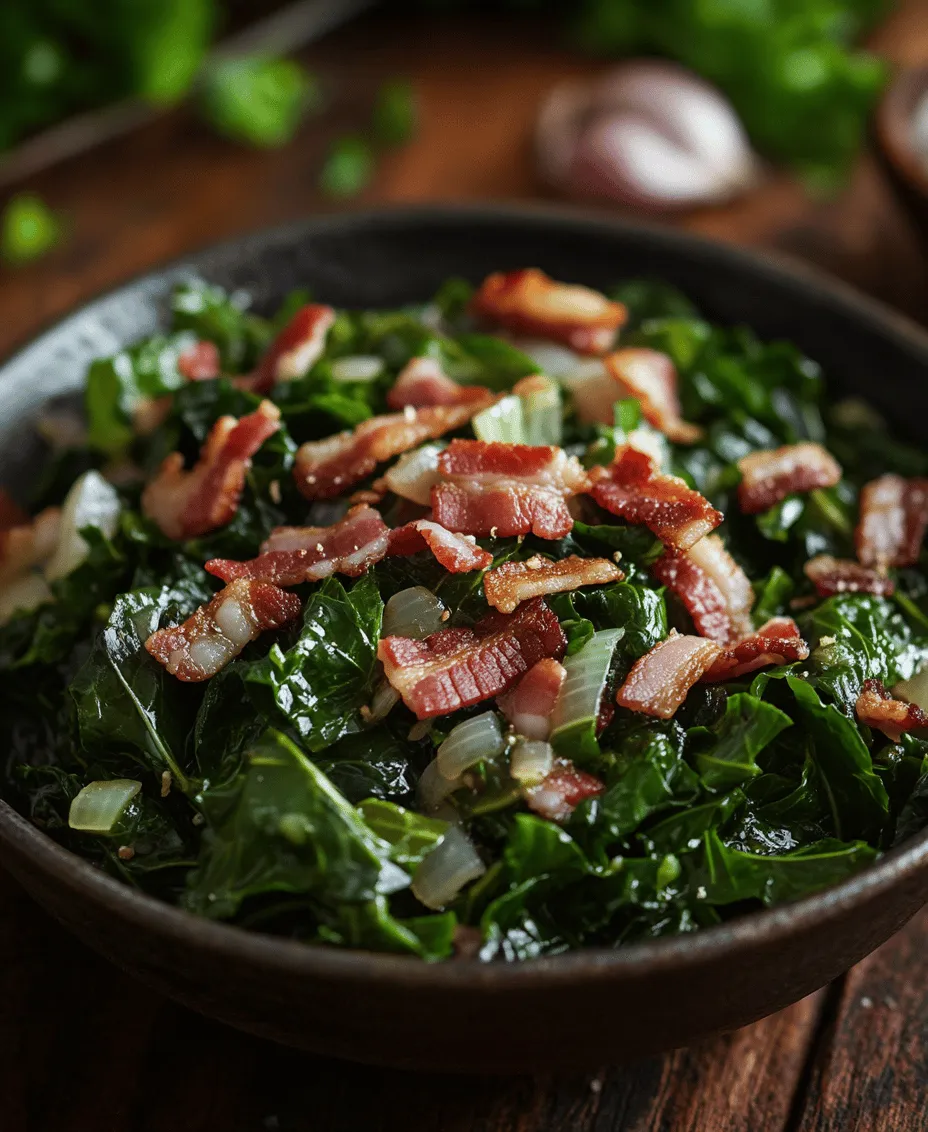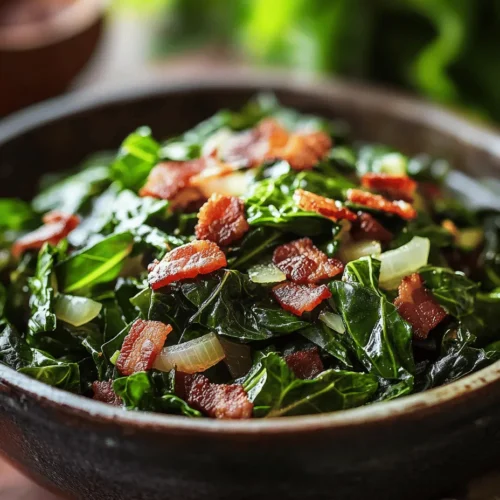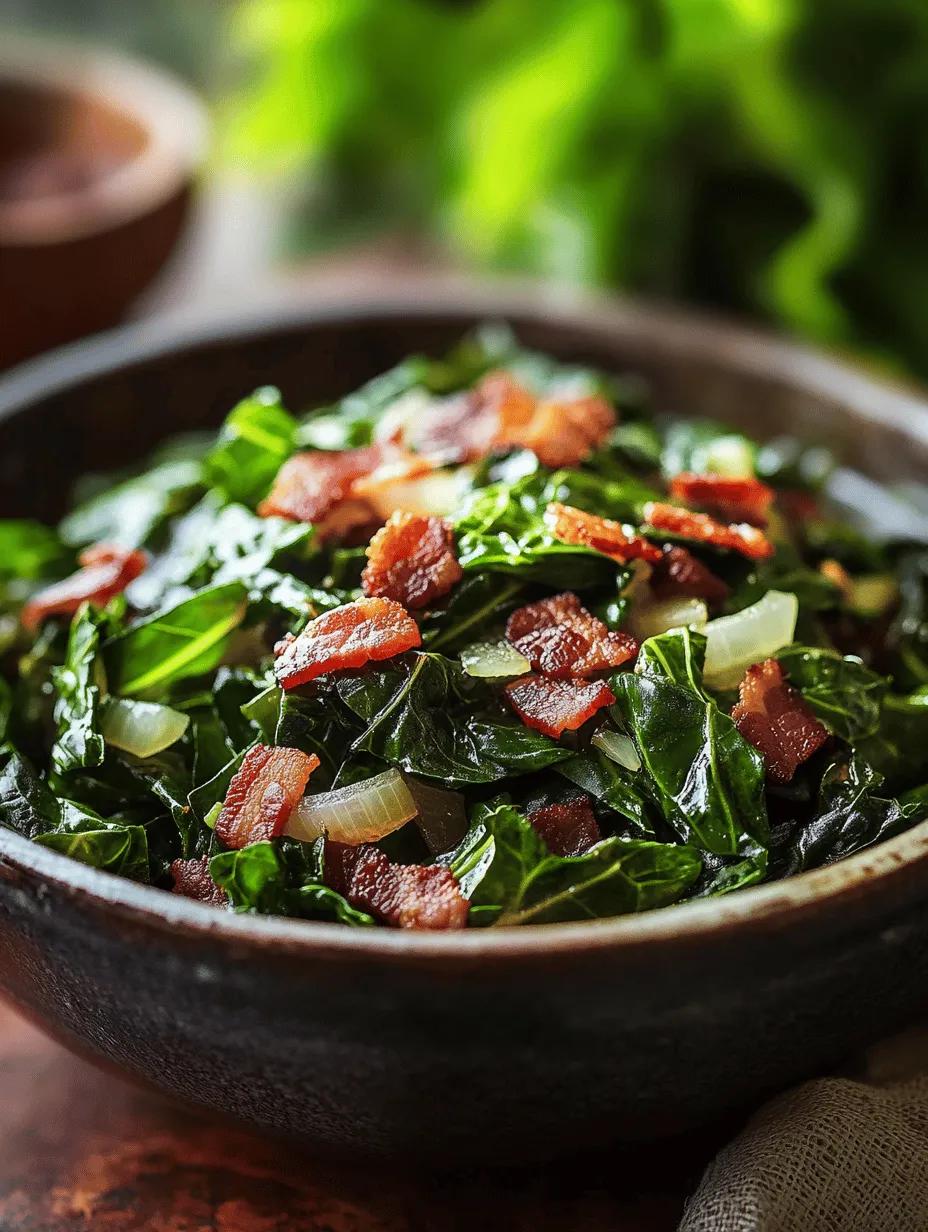Introduction
Collard greens are a staple in many kitchens, known for their robust flavor and impressive nutritional profile. This leafy green, belonging to the Brassica family, has been a dietary mainstay in various cultures, particularly in Southern cooking, where it holds a special place on the dinner table. Rich in vitamins and minerals, collard greens are not just a delicious addition to meals; they are also a powerhouse of nutrients that can contribute to a healthier lifestyle.
In this article, we will guide you through the preparation of Quick Collard Greens with Bacon, a recipe that perfectly marries the health benefits of collard greens with the rich, savory flavors of bacon. This dish stands out for its quick preparation time, making it an ideal choice for busy weeknights or as a vibrant side dish for special occasions. The simplicity of the recipe allows the natural flavors of the ingredients to shine, while the addition of bacon elevates the dish to a new level of comfort food.
Collard greens are not just a Southern delicacy; they are enjoyed worldwide in various forms. From the rich, spicy stews of Africa to the comforting braises in the Southern United States, collard greens have a versatile presence in global cuisine. Their ability to absorb flavors makes them an excellent companion for meats, spices, and hearty broths, creating a delightful culinary experience.
The Nutritional Benefits of Collard Greens
When it comes to superfoods, collard greens are often overlooked. These greens are not only low in calories but are also packed with essential nutrients. They are an excellent source of vitamins A, C, and K, as well as calcium, iron, and fiber. A single serving of collard greens can provide a significant portion of your daily intake of these essential vitamins and minerals.
The high fiber content of collard greens promotes digestive health and helps maintain a healthy weight by keeping you feeling fuller for longer. Additionally, collard greens are rich in antioxidants, which can combat oxidative stress in the body, potentially reducing the risk of chronic diseases.
Perhaps one of the most notable health benefits of collard greens is their anti-inflammatory properties. Regular consumption of these greens can contribute to heart health by lowering cholesterol levels and supporting overall cardiovascular function. The combination of nutrients found in collard greens, particularly their high vitamin K content, is crucial for maintaining bone health and preventing osteoporosis.
Incorporating collard greens into your diet is an easy way to boost your nutrient intake. Whether sautéed, steamed, or added to soups and stews, these versatile greens can be enjoyed in various dishes, making them a valuable addition to any meal plan.
Why Bacon? The Flavor Enhancer
In Southern cuisine, bacon is more than just a flavor enhancer; it is a culinary tradition that embodies comfort and richness. The smoky, salty essence of bacon adds depth to dishes, making it a perfect pairing for the earthy taste of collard greens. The fat rendered from bacon not only enhances flavor but also helps to tenderize the greens, creating a delightful mouthfeel.
The flavor profile of bacon complements the slight bitterness of collard greens beautifully, creating a balanced dish that is both satisfying and indulgent. As the bacon cooks, it releases its savory juices, which mingle with the greens, infusing them with a rich, meaty flavor that elevates the dish from ordinary to extraordinary.
While some may consider bacon an indulgence, this recipe strikes a healthy balance between nutrition and flavor. By using a moderate amount of bacon, you can enjoy the delightful taste without overwhelming the health benefits of the collard greens. Furthermore, you can always adjust the amount of bacon to suit your dietary preferences, ensuring that you still get the satisfaction of this beloved ingredient.
Ingredients Breakdown
To make Quick Collard Greens with Bacon, you will need the following ingredients, each contributing to the dish’s overall flavor and health benefits:
Collard Greens
When selecting collard greens, look for vibrant, dark green leaves that are firm and free from blemishes. Fresh collard greens should have a crisp texture and a slightly waxy surface, indicating their freshness. When preparing collard greens, it’s essential to wash them thoroughly to remove any dirt or grit. After washing, remove the tough stems by either cutting them out or tearing the leaves away from the stalk. This will ensure a more tender eating experience, as the stems can be fibrous and chewy.
Bacon
For this recipe, you can use your favorite type of bacon. Traditional pork bacon provides a classic flavor, but feel free to explore alternatives like turkey or plant-based bacon for a lighter option. The key is to choose bacon that crisps up nicely, as the texture will add to the overall experience of the dish. Cooking the bacon until it is golden brown allows it to render its fat, which will then be used to sauté the collard greens. This step is crucial for developing the dish’s flavor base.
Onion
Onion is another essential ingredient in this recipe, adding a layer of sweetness and depth to the dish. A medium yellow or white onion works well, as it complements the flavors of the collard greens and bacon. Sautéing the onions in the rendered bacon fat enhances their natural sweetness, creating a fragrant base that enriches the overall flavor profile of the greens.
Garlic
Garlic is a must-have in many savory dishes, and it is no different in this recipe. The aromatic qualities of garlic pair wonderfully with the earthiness of collard greens and the savory richness of bacon. In addition to its flavor benefits, garlic is known for its health properties, including anti-inflammatory effects and immune-boosting capabilities. Mincing fresh garlic cloves and adding them to the sautéed onions infuses the dish with a delightful aroma and taste.
Chicken Broth
Chicken broth serves as the cooking liquid for the collard greens, enhancing their flavor. It adds richness and depth, allowing the greens to absorb the savory notes. For those with dietary restrictions, you can easily substitute chicken broth with vegetable broth or even water, ensuring that everyone can enjoy this delicious dish. The broth not only contributes to the flavor but also helps to soften the collard greens as they cook, making them more tender and palatable.
By understanding the role of each ingredient in Quick Collard Greens with Bacon, you can appreciate how they come together to create a flavorful, nutritious dish that embodies the essence of Southern cooking. In the next section, we will delve into the step-by-step instructions to prepare this delightful recipe, ensuring that you can replicate this crowd-pleaser in your own kitchen.

The Role of Apple Cider Vinegar in Collard Greens
Apple cider vinegar plays an essential role in balancing the flavors of collard greens with bacon, offering a tangy brightness that cuts through the richness of the bacon. This ingredient is not only a flavor enhancer but also contributes to the nutritional profile of the dish. Apple cider vinegar contains acetic acid, which can aid in digestion and may help to maintain healthy blood sugar levels. When added to collard greens, it helps preserve essential nutrients during cooking, making your dish not only delicious but also a smart choice for health-conscious eaters.
The Science of Sugar in Savory Dishes
While sugar may seem out of place in a savory dish, it plays a crucial role in elevating the overall flavor profile of collard greens. Sugar, when used in moderation, balances the bitterness of the greens and complements the saltiness of the bacon. This balance is essential for creating a harmonious dish. The Maillard reaction, which occurs when sugar is heated, helps develop complex flavors, enhancing the depth of your collard greens. A small amount of sugar can transform an otherwise one-dimensional flavor into something rich and satisfying.
The Importance of Seasoning: Salt and Pepper
Salt and pepper are fundamental seasoning agents that can dramatically enhance the flavor of any dish, including collard greens. Salt helps to draw out moisture and flavor from ingredients, making them more pronounced. It also helps to soften the greens, making them tender and palatable. Black pepper introduces a subtle heat that rounds out the flavors without overpowering them. When seasoning your collard greens, it’s vital to taste as you go, ensuring that you achieve the perfect balance of flavors tailored to your preference.
Step-by-Step Cooking Instructions
Step 1: Cooking the Bacon
To achieve perfect crispiness, begin by cutting your bacon into bite-sized pieces. Place the bacon in a large skillet over medium heat. Allow the bacon to render its fat slowly, which will help it crisp without burning. Stir occasionally to ensure even cooking. Once the bacon is golden brown and crispy (about 8-10 minutes), use a slotted spoon to transfer it to a plate lined with paper towels to drain excess grease. This step is crucial as it prevents your greens from becoming greasy later on.
Step 2: Sautéing Onions and Garlic
In the same skillet, using the bacon fat left behind (this adds flavor), add diced onions. Sauté the onions over medium heat until they are translucent, about 5 minutes. This step is vital for building flavor; however, be mindful not to let them brown too much. After the onions have softened, add minced garlic and cook for an additional minute until fragrant. Stirring continuously will help avoid burning the garlic, which can impart a bitter taste.
Step 3: Combining Ingredients
Once the onions and garlic are cooked, it’s time to add the cleaned and chopped collard greens to the skillet. Stir the greens into the mixture, ensuring they are evenly coated with the bacon fat, onions, and garlic. This step allows the flavors to meld together beautifully. Next, pour in a splash of apple cider vinegar and sprinkle a small amount of sugar over the greens. Toss everything to combine, ensuring that the vinegar and sugar are evenly distributed among the greens.
Step 4: Temperature Control During Simmering
After combining all the ingredients, add enough chicken or vegetable broth to the skillet to cover the greens. Increase the heat to bring the mixture to a simmer. Once simmering, reduce the heat to low, cover the skillet, and let the collard greens cook for about 30-45 minutes. This slow cooking process allows the greens to become tender and absorb all the delicious flavors. Be sure to check occasionally, stirring gently to ensure even cooking. Adjust the seasoning with salt and pepper to taste, if necessary.
Serving Suggestions
Collard greens with bacon are incredibly versatile and can complement various main dishes. Here are some ideas for pairing them:
– Fried Chicken: The crispy texture and savory flavor of fried chicken pair perfectly with the richness of collard greens, creating a classic Southern meal.
– Grilled Meats: Serve collard greens alongside grilled steak, pork chops, or chicken. The smoky flavors of the grilled meats enhance the overall meal experience.
– Family-Style vs. Individual Plating: For a casual gathering, serve collard greens in a large bowl for family-style dining, allowing guests to help themselves. For a more formal setting, consider individual plating for an elegant presentation.
Incorporating collard greens into a larger meal can also be achieved with complementary side dishes such as cornbread, mashed potatoes, or a hearty salad. This not only adds variety to your meal but also showcases the collard greens as a star side dish.
Storing and Reheating Collard Greens
Best Practices for Storing Leftovers
If you have leftover collard greens, storing them properly is essential to maintain freshness. Allow the greens to cool completely before transferring them to an airtight container. You can refrigerate them for up to 4 days. If you want to store them for a more extended period, consider freezing them. To do this, portion the greens into freezer-safe bags or containers and remove as much air as possible before sealing. Frozen collard greens can last for up to 3 months.
Reheating Methods
To reheat your collard greens while maintaining their texture and flavor, the stovetop method is recommended. Place them in a skillet over low heat, adding a splash of water or broth to prevent sticking. Stir occasionally until heated through. Alternatively, you can microwave them in a microwave-safe container, covered with a damp paper towel, for about 2-3 minutes on medium power, stirring halfway through.
Creative Uses for Leftover Collard Greens
If you find yourself with leftover collard greens, there are numerous creative ways to incorporate them into other dishes:
– Soups: Add chopped collard greens to hearty soups or stews for added nutrition and flavor.
– Casseroles: Mix collard greens into a casserole for a nutritious twist on classic dishes like lasagna or baked pasta.
– Stir-Fries: Toss them into a stir-fry with other vegetables and proteins for a quick and healthy meal.
Conclusion
This quick collard greens with bacon recipe not only showcases the simplicity of cooking but also highlights the deliciousness that can be achieved with minimal effort. With a few key ingredients and straightforward steps, you can create a dish that is both flavorful and nutritious. The versatility of collard greens allows them to fit seamlessly into a variety of meals, making them a staple in a healthy diet.
Embrace the rich flavors and health benefits of collard greens, and don’t hesitate to make them a regular feature on your dining table. Whether enjoyed as a side dish or incorporated into a larger meal, collard greens are an excellent choice that brings a taste of tradition into modern cooking.


